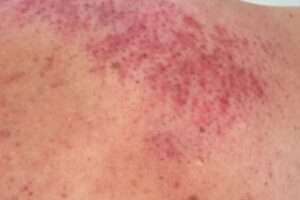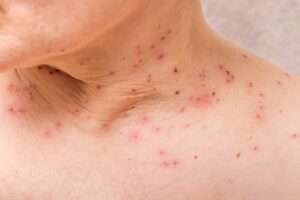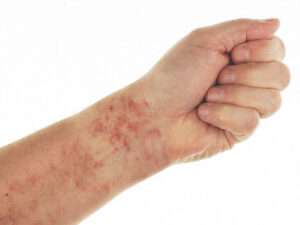Pinprick red dots on skin not itchy are often ignored, but they can be bothersome and even painful. Learn about pin prick red dots on skin not itchy , what causes them, how to treat them.
Pinprick red dots on skin not itchy
If you’ve noticed pinprick red dots on your skin that aren’t itchy, you may have dermatitis. This article will explain what dermatitis is and why the rash occurs.
The first step to treating a dermatitis outbreak is identifying its cause. There are many different causes of dermatitis including allergies, irritants, infections, medications or diseases like psoriasis or eczema. If you think there might be an underlying cause for your rashes visit a doctor for diagnosis and treatment options.

If you’ve been noticing red dots on your skin that don’t itchy, then you need to know they could be a sign of an allergy. The most common allergen is poison ivy, but it can also be from any plant in the cashew family such as mangoes and pistachios. These tiny little bumps are called urticaria or hives and they happen when an allergic reaction causes blood vessels near the surface of the skin to swell up and leak fluid into surrounding tissue which causes swelling.
Once the cause has been identified then there are several things you can do at home to relieve symptoms such as cold compresses, avoiding allergens in your environment and moisturizing affected areas several times a day.
What are tiny pin sized red dots on skin?
Every day, people are asking what these tiny pin sized red dots on skin are. They come in all different sizes and shapes and can be found anywhere on the body. These little patches of skin are caused by a variety of things including bacteria, yeast or fungi, mites or parasites called Demodex folliculorum which live in human hair follicles. These are usually harmless but there is always the risk for infection due to bacterial overgrowth when using antibiotics that kill off protective gut flora.
Why do I have red spots that aren’t itchy?
Many people think that red spots are itchy, but not everyone who has them will experience itchiness. Red spots can be a sign of different types of skin conditions and diseases. It is important to know what type of condition you have before seeking treatment because the treatments for each condition vary significantly. Here’s a list of some common red spot conditions: erythema multiforme, dermatitis herpetiformis, rosacea, seborrheic dermatitis, acne vulgaris/papules/pustules/maculopapular rash or psoriasis.

Red spots can vary in size from tiny dot-like marks to larger raised patches of skin called papules or vesicles, depending on how severe the condition is. These small areas of inflammation may come alone or in groups, but many people don’t know the cause of their rash or where else it could show up.
The human body is constantly fighting germs and bacteria, but sometimes the immune system overreacts to a harmless substance like pollen or grass. This can cause inflammation in the form of hives, eczema, or contact dermatitis. If you notice any unusual symptoms after taking medication or eating something new, go see your doctor as soon as possible.
What causes small red pinprick spots?
Small red pinprick spots can be caused by a number of different things. For example, they could be caused by an allergic reaction to something you’ve eaten or touched. They could also be caused by a skin condition such as dermatitis herpetiformis and rosacea that causes the skin to react in certain ways. Finally, small red spot can also occur when blood vessels break under the skin due to extreme temperatures or sunburns.

Small red pinprick spots can be caused by a number of things, from bug bites to skin disorders.
What do leukemia spots look like?
Leukemia is a cancer of the blood cells. Although leukemia can affect any cell type in your body, it most often attacks red blood cells and white blood cells. Leukemia spots are either due to an increase in abnormal white blood cells or a decrease in normal white blood cells.
The different types of leukemia vary depending on which kind of cell is affected and how quickly the disease progresses. The four major categories include: chronic lymphocytic leukemia (CLL), acute myeloid leukemia (AML), chronic myelogenous/chronic granulocytic leukemia (CML/CGLL) and hairy-cell leukemias. Each type has its own unique characteristics that make them easy to differentiate from one another including physical appearance.
Leukemia is a cancer of the blood cells. Symptoms of leukemia include fatigue, fever, chills and night sweats. There are two types of leukemia: acute and chronic. Acute leukemia progresses quickly while chronic leukemia takes a longer time to progress into full blown cancer.

Leukemia can be found in many different areas of the body depending on which type it is and where it originates from in the bone marrow or lymph system. One common place leukemias originate from is the spleen because this organ filters out old red blood cells that have stopped working properly so they cannot become infected with bacteria or viruses causing infection-related death if not removed by white blood cells called macrophages. There are several types of leuke
Leukemia is a type of cancer that can develop in the blood cells, bone marrow, or lymph nodes. This disease affects individuals of all ages but is most common among children under age 15. The symptoms are many and include fatigue, fever, frequent infections, bleeding easily, bruising easily, shortness of breath or trouble breathing because fluid builds up in your lungs (called pleural effusion), pale skin coloration (pallor), weight loss without trying to lose weight (cachexia) and swollen glands (lymphadenopathy).
Leukemia spots can be typically identified by their red coloration after they have been pressed on with a finger for several seconds.
Leukemia is a type of cancer that affects the blood and bone marrow. It occurs when there are too many white blood cells in the body, which can be caused by normal cells in the body growing out of control. Although leukemia is most common among adults over age 65, it can occur at any age. The disease often has few or no symptoms until late stages when signs appear such as fever, easy bruising or bleeding, fatigue, shortness of breath and pale skin color.
Read More:

